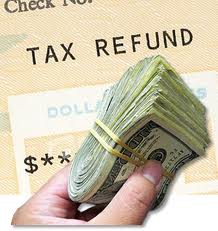 According to USA Today, the average tax refund last year was over $3,000. If you are anywhere near average, you will soon have thousands of dollars in your pocket – money which will disappear if you do not have a plan for it. Not everyone should have the same plan, but all should create a strategy which will mesh with their overall financial well being. What is the best plan for you? Read on.
According to USA Today, the average tax refund last year was over $3,000. If you are anywhere near average, you will soon have thousands of dollars in your pocket – money which will disappear if you do not have a plan for it. Not everyone should have the same plan, but all should create a strategy which will mesh with their overall financial well being. What is the best plan for you? Read on.
- If you have consumer debt, jump-start a debt snowball. By using that $3,000 to get rid of your smallest debts, you will be able to make bigger payments on your remaining debts. Continue to knock them off one at a time, from smallest to largest, and watch your debt snowball grow. Note: I would not include my house payment in this snowball.
- If your consumer debt is paid off, build your emergency fund. Most financial planners recommend an emergency fund of at least six months expenses. Therefore, if your monthly spending budget is $4,000, you need an emergency fund of $24,000. If you are not there, your $3,000 refund will definitely help.
- If you have no consumer debt and your emergency fund is in place, invest for retirement. A good rule of thumb is to invest 15% of your take home pay for your retirement, so if you are not quite there, put that $3,000 to work. In 20 years, at an 8% rate of return, $3,000 annually would grow to nearly $150,000.
- If you have satisfied steps 1-3 above, save for your children’s college. Consider a Coverdale Educational Savings Account or a 529 plan. Each has its own advantages, but both will earn tax free growth (as long as the investment is used toward a college education). I like tax free, don’t you?
- If you have already satisfied all of the above steps, take a cruise. Surprised? Don’t be. You are doing great with your finances, so loosen up and enjoy yourself. You deserve it!
Bonus plan: bring the money home each month. Many mistakenly think that they somehow “win” when they get a refund from the IRS. Not true. A refund simply means that the IRS is returning your money after hanging onto it for a year. You can keep your Uncle Sam’s hands off of your money by upping the number of exemptions you claim on your W-4 form. Doing so could give you as much as an additional $250 each month throughout the year instead of a $3,000 refund after the year is over.
Zig Zigler once said that those who aim at nothing will hit it every time. Don’t let your refund vaporize…have a plan and follow it. You will be glad you did.
Readers: Are you expecting a tax refund? What is YOUR plan?
Leave a Reply